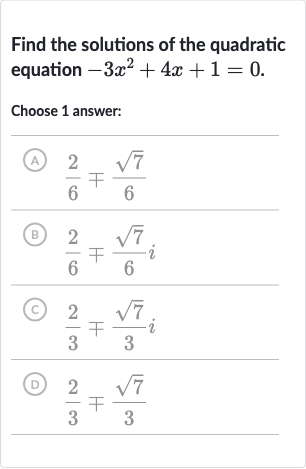AI tutor
Welcome to Bytelearn!
Let’s check out your problem:

Find the solutions of the quadratic equation .Choose answer:(A) (B) (C) (D)
Full solution
Q. Find the solutions of the quadratic equation .Choose answer:(A) (B) (C) (D)
- Quadratic Formula: To find the solutions of the quadratic equation , we can use the quadratic formula, which is , where , , and are the coefficients of the terms in the quadratic equation .In this case, , , and .
- Calculating the Discriminant: First, we calculate the discriminant, which is the part under the square root in the quadratic formula: .Discriminant = .
- Determining the Number of Solutions: Since the discriminant is positive, we will have two real solutions.Now we can apply the quadratic formula:.
- Applying the Quadratic Formula: We simplify the square root of by factoring it into and taking the square root of out of the square root sign: .
- Simplifying the Square Root: Now we substitute the simplified square root back into the quadratic formula:.
- Substituting the Simplified Square Root: We can simplify the fraction by dividing both the numerator and the denominator by :.
- Simplifying the Fraction: Finally, we can write the solutions as two separate numbers:x = or x = .
More problems from Domain and range
QuestionGet tutor help
